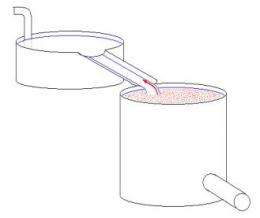May 18, 2011 report
Some particles are able to flow up small waterfalls, physicists show

(PhysOrg.com) -- In a paper published on arXiv, Cuban physicist Ernesto Althsuler and his team at the University of Havana, describe how they set out to reproduce a phenomenon they had observed while brewing the Argentinean drink mate, a type of tea. Althsuler noticed that after causing hot water to drop from one vessel down a very slight waterfall into another containing tea leaves, some of the leaf particulates managed to make their way back up the waterfall and into the hot water vessel. In their subsequent research, they discovered that a small counter-flow can come into existence in small drop waterfalls along the sides; enough to carry small particles.
With just a small bit of research, the team was able to show what seems to be counterintuitive; that it truly is possible for some particles (and some of the liquid itself) to travel up a very small waterfall and into the reservoir behind it. While most anyone that has observed moving water has likely noted the whirls and eddies that form when water tries to flow along or past obstacles, it’s difficult to imagine such counter-flows being created with sufficient force to actually push the fluid uphill. Althsuler et al. show that in fact, it can.
To see what was going on, they used two lab containers; one to hold the room temperature water, the other to hold the chalk they used instead of mate leaf bits (figuring it would be much easier to follow with the naked eye). They then placed an open half-cylinder shaped channel between the two containers that would allow water to flow smoothly from the first container down the channel, where it would then drop into the second container. With this setup, they discovered that as the liquid came rushing down the channel, the main mass of water traveled down the center, creating vortices that caused small amounts of fluid to travel along the edges of the channel in the opposite direction, allowing the chalk to work its way up to the higher level container. But, they also discovered by varying the height of the channel, that it only occurred when the dropping distance was very slight; in this case, 1 centimeter, or less.
As a result of this study, it’s likely that certain industrial processes might have to be modified to make certain unintentional contamination doesn’t occur that is currently being overlooked. Also, its likely future research on this phenomenon will need to be done to determine if other factors can affect the height of the fall or the amount of particulate that is able to travel uphill to another vessel.
More information: Upstream contamination in water pouring, arXiv:1105.2585v1 [physics.flu-dyn] arxiv.org/abs/1105.2585
Abstract
We report the observation of upstream transport of floating particles when clear water is poured on the surface of a flat water surface on which mate or chalk particles are sprinkled. As a result, particles originally located only at the surface of the lower container can contaminate the upper water source by "riding" on vorticial water currents. We speculate that Marangoni forces in combination with geometry-induced vortices may explain the observed phenomenon.
© 2010 PhysOrg.com




















